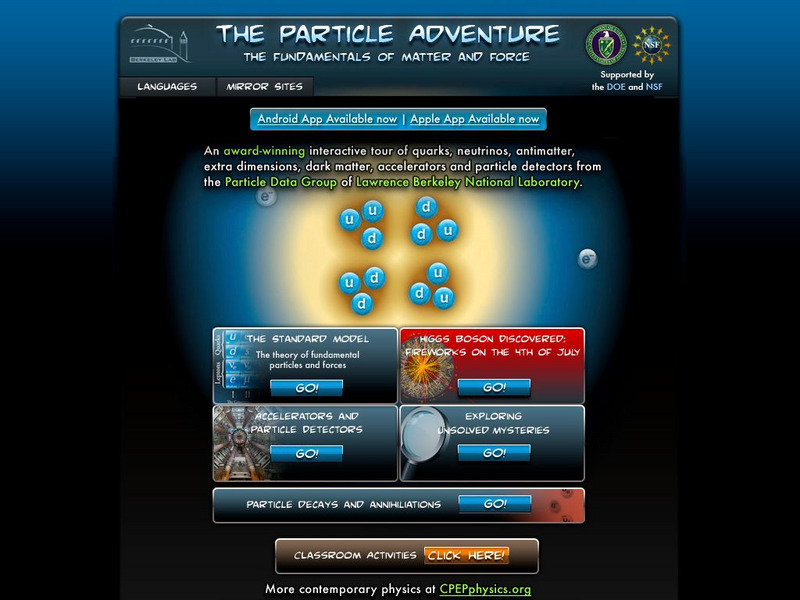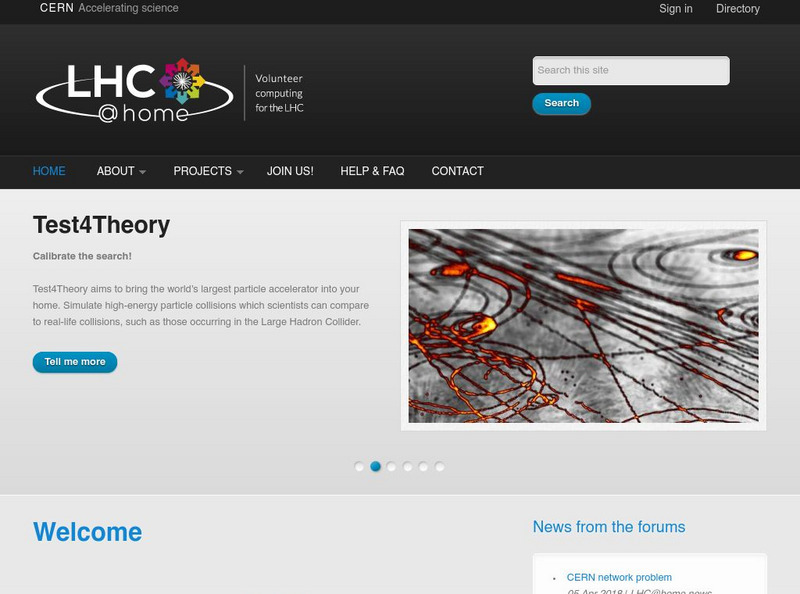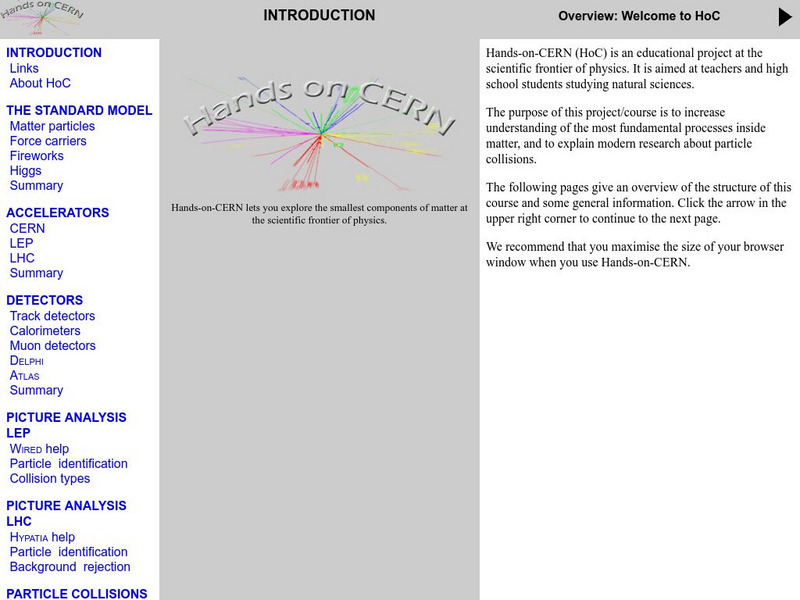CK-12 Foundation
Ck 12 Exploration Series: Simulations: Physics: High Energy Particles
[Free Registration/Login Required] A video module that allows students to uncover the relationship between speed and kinetic energy in the context of a particle accelerator.
Other
Particle Physics at Discovery's Horizon
Explore the Large Hadron Collider (LHC) and how the U.S. Department of Energy and National Science Foundation have collaborated with this huge project and related experiments. You can find facts about the LHC, browse a bank of high...
Other
Cern: The Compact Muon Solenoid Experiment
The Compact Muon Solenoid Experiment (CMS), an LHC experiment, detects muons, electrons and photons, provides momentum measurements, and, like ATLAS, is responsible for detecting the Higgs boson. This CERN website offers news about CMS,...
Lawrence Berkeley National Laboratory
Berkeley Lab: The Particle Adventure
Visit this site for an interactive tour of the atom and all aspects of particle physics. View the animations available with almost every description on this site. A great place for the fundamentals of particles and forces including a...
TED Talks
Ted: Ted Ed: The Basics of the Higgs Boson
Using the Socratic method, CERN scientists Dave Barney and Steve Goldfarb explain the exciting implications of the Higgs boson. [6:30]
TED Talks
Ted: Ted Ed: How Does an Atom Smashing Particle Accelerator Work?
An atom smasher, or particle accelerator, collides atomic nuclei together at extremely high energies, using engineering that exploits incredibly cold temperatures, very low air pressure, and hyperbolically fast speeds. Don Lincoln...
Symmetry Magazine
Symmetry Magazine: Explain It in 60 Seconds: Luminosity
Luminosity, described here, is a scale for measuring how efficiently a collider works. "Explain It In 60 Seconds" is an article series that aims to summarize in a few paragraphs the meaning of different concepts in particle physics.
Symmetry Magazine
Symmetry Magazine: Explain It in 60 Seconds: Acceleration of Particles
The process of particle acceleration is described. "Explain It In 60 Seconds" is an article series that aims to summarize in a few paragraphs the meaning of different concepts in particle physics.
Symmetry Magazine
Symmetry Magazine: Explain It in 60 Seconds: Magnet Quench
A magnet quench, explained here, is a routine event that happens within a particle accelerator that can require the accelerator to be shut down for a period of repair, losing valuable research time. "Explain It In 60 Seconds" is an...
Symmetry Magazine
Symmetry Magazine: Explain It in 60 Seconds: Particle Accelerators
Particle accelerators and what how they are used in research are explained briefly but succinctly here. "Explain It In 60 Seconds" is an article series that aims to summarize in a few paragraphs the meaning of different concepts in...
Other
European Organization for Nuclear Research: Lhc@home: The Lhc
A basic explanation of the Large Haldron Collider, a particle accelerator near Geneva, works.
Other
Cern Courier: International Journal of High Energy Physics
A monthly online publication featuring the latest news and current topics surrounding high energy physics.
Other
Cern: The Large Hadron Collider
A thorough introduction to the Large Hadron Collider (LHC), organized into several sections. Read about LHC experiments, milestones, and safety measures.
Other
Hands on Cern: Explore the Smallest Components of Matter
An online course in particle physics with colorful images, charts and animations. Begin by learning about the Standard Model and the types of particles, particle families, and forces, then carry this knowledge over to your study and...
TED Talks
Ted: Ted Ed: Why Do Hospitals Have Particle Accelerators?
Doctors are using injected radioactive drugs that circulate through the body and act as a beacon for PET scanners. These diagnostic tools can detect the spread of diseases before they can be spotted with other types of imaging. Pedro...
Khan Academy
Khan Academy: Step 2 (Spring Mass System)
This program simulates a particle connected to an anchor by a spring. Try changing the value of the k variable. Press "Restart" after changing the value. How does the length of the spring change as k increases? How does the speed of the...
Khan Academy
Khan Academy: Position, Velocity and Acceleration
This 9-problem quiz/practice helps students understand how position, velocity and acceleration are related.
Lawrence Berkeley National Laboratory
Berkeley Lab: Cockroft Walton
Provides a description of the Cockroft-Walton accelerator built in 1932.
Other
Particle Physics at Discovery's Horizon: What Is the Lhc?
An introduction to the Large Hadron Collider (LHC), offering information on its location, its experiments, and what scientists hope to learn through this machine buried below Geneva, Switzerland. Click a menu of links to read details...














